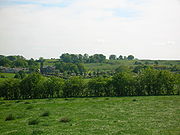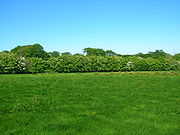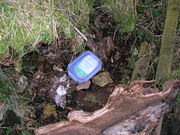
Thurgartstone
Encyclopedia
The Thurgatstane or Ogrestane is a famous stone near Dunlop
in East Ayrshire
in Scotland
. The Thurgatsane is thought to have been a rocking stone
at one time, but it no longer rocks.

One explanation of the name is that it derives from 'Thor's Great Stone'. Another is that the name comes from the phrase "Thou Great Stone" or just '"grit stane" (Paterson 1866). The term 'The Stone of the Ogre' may indicate some forgotten legend. Some names may be spelling errors originating in or propagated by the Ordnance Survey
or other maps. Another theory is that the name is derived from the word "Tagairtstane", which means "the priest's stone."
 The Thurgartstone is close to Dunlop
The Thurgartstone is close to Dunlop
on the Lugton Road is Black Burn Valley. In the middle of a field near the Chapel Crags is the Thurgatstane or Ogrestane. Dunlop or Boarland Hill, the site of Dunlop Castle once held by the De Ross family, can be seen from the stone.
The stone is in a sheltered spot, with ample running water. It is somewhat hidden from view.
St. Mary's Chapel.
The site is listed and protected by Historic Scotland
.
 There was a monastic settlement associated with the chapel of Saint Mary near the Thurgartstone site. The history of the site is apparently similar to the history of the Chapel Hill site at Chapeltoun
There was a monastic settlement associated with the chapel of Saint Mary near the Thurgartstone site. The history of the site is apparently similar to the history of the Chapel Hill site at Chapeltoun
.
There are steps cut into the rock that led up to the monk's cemetery. The monastery, original chapel and graveyard are no longer visible. There is a holy well
in the "field bordered by the burn." The new buildings called "Marys Chapel" at the site are built on the foundation of the original chapel.
celebrations and events at the site.
This 'Druid
ical' stone is thought by some to have been a 'rocking or logan'
stone at one time. It is now firmly set in the 'rubbish' and dirt.
There are records showing that "even as late as the time of Popery", Catholics would do penance by crawling on their knees around this stone, crying "O thou grit stane". Apparently they held a belief that the Deity was present in the Thurgartstone (MacIntosh 1894).
Farmers from Brandleside Farm did not remove the stone. They also kept their ploughs a set distance away from the Thurgartstone. This was presumably because legend has it that there were pagan burials around this monument (Paterson 1866).
The ancient Dunlop Carlin stone
is on the other side of the village.
 A traditional geocache
A traditional geocache
is located nearby - go to the Geocaching website, register and find it. You will really need a GPS to locate this cache. The nearby Carlin stone
also has a Geocache, as does the Templehouse Community Woodland.
Corsehill, Lainshaw, Robertland and Dunlop
The old Barony and castle of Corsehill lay within the feudal Baillerie of Cunninghame, near Stewarton, now East Ayrshire, Scotland.- The Lands of Corsehill :...
in East Ayrshire
East Ayrshire
East Ayrshire is one of 32 council areas of Scotland. It borders on to North Ayrshire, East Renfrewshire, South Lanarkshire, South Ayrshire and Dumfries and Galloway...
in Scotland
Scotland
Scotland is a country that is part of the United Kingdom. Occupying the northern third of the island of Great Britain, it shares a border with England to the south and is bounded by the North Sea to the east, the Atlantic Ocean to the north and west, and the North Channel and Irish Sea to the...
. The Thurgatsane is thought to have been a rocking stone
Rocking stone
Rocking stones are large stones that are so finely balanced that the application of just a small force causes them to rock. They are found throughout the world. Some are man-made megaliths, but others are natural, often left by glaciers.Logan or rocking stones are known in Scotland sometimes as...
at one time, but it no longer rocks.

Name
The Thurgartstane or Ogrestane, or in modern English, the Thurgartstone or Ogrestone, is also known as the Thorgatstane, the Field Spirit Stane, T'Ogra Stane, Thugart Stane, Ogirtstane, Fiend's Stane, Ogart Stane, Horgar Stane or Thougritstane.One explanation of the name is that it derives from 'Thor's Great Stone'. Another is that the name comes from the phrase "Thou Great Stone" or just '"grit stane" (Paterson 1866). The term 'The Stone of the Ogre' may indicate some forgotten legend. Some names may be spelling errors originating in or propagated by the Ordnance Survey
Ordnance Survey
Ordnance Survey , an executive agency and non-ministerial government department of the Government of the United Kingdom, is the national mapping agency for Great Britain, producing maps of Great Britain , and one of the world's largest producers of maps.The name reflects its creation together with...
or other maps. Another theory is that the name is derived from the word "Tagairtstane", which means "the priest's stone."
Location

Dunlop, East Ayrshire
Dunlop is a village and parish in East Ayrshire, Scotland. It lies on the A735, north-east of Stewarton, seven miles from Kilmarnock. The road runs on to Lugton and the B706 enters the village from Beith.-The village:...
on the Lugton Road is Black Burn Valley. In the middle of a field near the Chapel Crags is the Thurgatstane or Ogrestane. Dunlop or Boarland Hill, the site of Dunlop Castle once held by the De Ross family, can be seen from the stone.
The stone is in a sheltered spot, with ample running water. It is somewhat hidden from view.
Description
The Thurgartston is a "glacial erratic stone". It is composed of blue augitic porphyrite. This rock is different than the 'native' stone of the area. The Thurgartston weighs about 25 tons and the part above ground is about twelve feet by eight feet (Bayne 1935). It is set near the site of the pre-ReformationProtestant Reformation
The Protestant Reformation was a 16th-century split within Western Christianity initiated by Martin Luther, John Calvin and other early Protestants. The efforts of the self-described "reformers", who objected to the doctrines, rituals and ecclesiastical structure of the Roman Catholic Church, led...
St. Mary's Chapel.
The site is listed and protected by Historic Scotland
Historic Scotland
Historic Scotland is an executive agency of the Scottish Government, responsible for historic monuments in Scotland.-Role:As its website states:...
.
Monastic settlement

Chapeltoun
Chapeltoun is an estate on the banks of the Annick Water in East Ayrshire, Scotland. This is a rural area famous for its milk and cheese production and the Ayrshire or Dunlop breed of cattle.-Templeton and the Knights Templar:...
.
There are steps cut into the rock that led up to the monk's cemetery. The monastery, original chapel and graveyard are no longer visible. There is a holy well
Holy well
A holy well, or sacred spring, is a small body of water emerging from underground and revered either in a Pagan or Christian context, often both. Holy wells were frequently pagan sacred sites that later became Christianized. The term 'holy well' is commonly employed to refer to any water source of...
in the "field bordered by the burn." The new buildings called "Marys Chapel" at the site are built on the foundation of the original chapel.
Associated Beliefs
The Thurgartstone has long been associated with pagan ritual practices. There are still May DayMay Day
May Day on May 1 is an ancient northern hemisphere spring festival and usually a public holiday; it is also a traditional spring holiday in many cultures....
celebrations and events at the site.
This 'Druid
Druid
A druid was a member of the priestly class in Britain, Ireland, and Gaul, and possibly other parts of Celtic western Europe, during the Iron Age....
ical' stone is thought by some to have been a 'rocking or logan'
Rocking stone
Rocking stones are large stones that are so finely balanced that the application of just a small force causes them to rock. They are found throughout the world. Some are man-made megaliths, but others are natural, often left by glaciers.Logan or rocking stones are known in Scotland sometimes as...
stone at one time. It is now firmly set in the 'rubbish' and dirt.
There are records showing that "even as late as the time of Popery", Catholics would do penance by crawling on their knees around this stone, crying "O thou grit stane". Apparently they held a belief that the Deity was present in the Thurgartstone (MacIntosh 1894).
Farmers from Brandleside Farm did not remove the stone. They also kept their ploughs a set distance away from the Thurgartstone. This was presumably because legend has it that there were pagan burials around this monument (Paterson 1866).
The ancient Dunlop Carlin stone
Carlin stone
Carlin Stone or Carlin Stane is the name given to a number of prehistoric standing stones and natural stone or landscape features in Scotland. The significance of the name is unclear, other than its association with old hags, witches, and the legends of the Cailleach.- Etymology :A 'Carle' in...
is on the other side of the village.
The Ogre and Thurgartstane Geocache

Geocaching
Geocaching is an outdoor sporting activity in which the participants use a Global Positioning System receiver or mobile device and other navigational techniques to hide and seek containers, called "geocaches" or "caches", anywhere in the world....
is located nearby - go to the Geocaching website, register and find it. You will really need a GPS to locate this cache. The nearby Carlin stone
Carlin stone
Carlin Stone or Carlin Stane is the name given to a number of prehistoric standing stones and natural stone or landscape features in Scotland. The significance of the name is unclear, other than its association with old hags, witches, and the legends of the Cailleach.- Etymology :A 'Carle' in...
also has a Geocache, as does the Templehouse Community Woodland.
See also
- Rocking Stones
- Corsehill, Lainshaw, Robertland and DunlopCorsehill, Lainshaw, Robertland and DunlopThe old Barony and castle of Corsehill lay within the feudal Baillerie of Cunninghame, near Stewarton, now East Ayrshire, Scotland.- The Lands of Corsehill :...
- Stones of Scotland
- Corsehill

